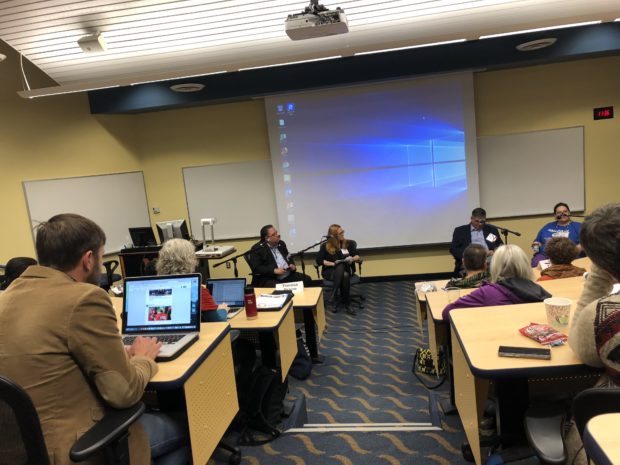
Indigenous rights panel at the 2018 SEJ Conference: Levi Rickert, Theresa Braine, Mark Trahant, Trina Redner. Image: Whitney McDonald
By Whitney McDonald
To accurately cover indigenous communities, reporters need to spend more time with them when developing a story.
“Go and let grandma feed you,” Trina Redner said at the 2018 Society of Environmental Journalists national conference recently in Flint, Michigan.
Redner, an activist and member of an indigenous community in Flint, was on a panel that explained how journalists can break the barrier with indigenous people to report on stories that need to be heard.
It’s the citizens who are on the frontline every single day, she said. But their communities are not fairly represented in the news and they need to be.
“The future of news is citizen journalism,” she said.
One issue with reporters is that they don’t take the time to sit down, listen and understand their community, she said. But that’s where the stories are. Reporters need to be patient, go sit at the table and listen to the elders that know the traditions, stories and issues in current and past indigenous communities.
Others agree. Clint Jacobs, who was not on the panel but is the natural heritage coordinator for First Nations at Walpole Island, Ontario, emphasizes the importance of taking time to listen to the history of the sovereign lands.
“We have two ears and one mouth for a reason,” he said.
Panelist Mark Trahant, editor at Indian Country Today, agreed that stories are where citizens are.
At protests at Standing Rock it was indigenous people that were on the frontline, spending weeks at a time standing up to protect their sacred land, he said.
The protesters are tired of being the only ones making a stand to protect their land.
“We are exhausted,” Redner said.
The panel also discussed the meaning of sacred land to indigenous people. Each panel member described the importance of environmental sovereignty.
Trahant used the Sherman Alexie poem “Communion,” to describe the relationship between the land and the natives: “We worship the salmon because we eat the salmon.”
The land ties to her family, Redner said. It is where they pray, where their children are born and where their ancestors are buried.
She hopes to be respected and understood by journalists who want to tell stories involving indigenous communities, she said.
Trahant wants members of indigenous communities to be recognized by news media for their bravery.
“Pay attention to who the heroes are,” Trahant said.
